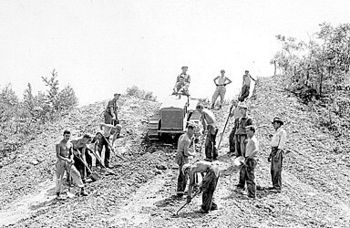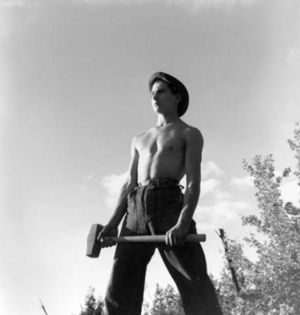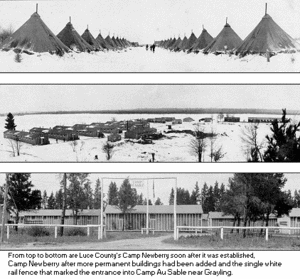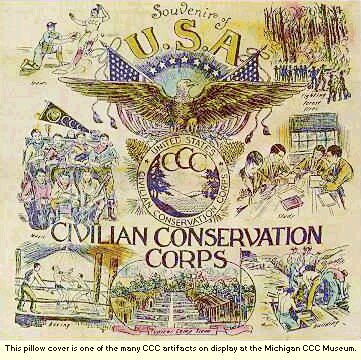Civilian Conservation Corps
 From Citizendium - Reading time: 6 min
From Citizendium - Reading time: 6 min

The Civilian Conservation Corps (CCC) was a work relief program for young men from unemployed families established on March 19, 1933 by President Franklin D. Roosevelt in his first hundred days. It was part of the New Deal designed to combat the poverty and unemployment of the Great Depression. The CCC became the most popular New Deal program among the general public and operated in every state and several territories. Some 3 million young men went to camps of about 200 men each for six month periods where they were paid to do outdoor construction work. The Indian Division was a major relief agency for Indian reservations.
Establishment[edit]
Roosevelt proposed conservation work as unemployment relief during the 1932 presidential campaign. Senate Bill 5.598, the Emergency Conservation Work Act; was signed into law on March 31, 1933. Roosevelt on May 7, 1933, extolled the CCC in a fireside address on the radio:
- "First, we are giving opportunity of employment to one-quarter of a million of the unemployed, especially the young men who have dependents, to go into the forestry and flood prevention work. This is a big task because it means feeding, clothing and caring for nearly twice as many men as we have in the regular Army itself. In creating this civilian conservation corps we are killing two birds with one stone. We are clearly enhancing the value of our natural resources and second, we are relieving an appreciable amount of actual distress."
Administrative roles[edit]
The Labor Department's role was to enroll participants into the program; the actual camps were operated by the Army, using 3,000 reserve officers who became camp directors. Each camp had a federal sponsor, usually a division of the Interior or Agriculture departments. The sponsor provided the project supervisor and hired the trained foremen necessary, called "LEMs" (Local Experienced Men), who in turn trained CCC apprentices. Each camp had an educational advisor provided by the Office of Education. The Army provided chaplains, and contracted locally for groceries, fuel, and equipment and for medical services. Each enrollee earned $30 a month; he kept $5 and the other $25 went to his family. By 1935 the CCC was promoting about 13% of enrollees to act as leaders (at $36-45 a month). The program cost about $1100 per year per full-time enrollee. Annual expenditures reached a maximum of $894 billion in 1936. Peak numbers came in August 1935 with 502,000 enrollees in 2,600 camps.
Within a week the Labor Department organized a National Re-Employment Service for CCC recruitment; later the CCC handled its own recruiting through local welfare boards. The usual requirement was that the boy's father had to be registered as unemployed. The first CCC enrollee entered on April 7, 1933, just thirty-seven days after Roosevelt's inauguration. Young men aged 17-23 enrolled for six months, with the option of enrolling for another six months, up to two years. There was little penalty for leaving early, and the "desertion" rate was 1-2% per month. In a short time there were 250,000 enrollees working in CCC camps, plus 25,000 veterans in special CCC camps, and 25,000 LEMs. By the time the CCC disbanded in 1942, over three million men had participated in it. The quota for African-American was 10%, and black CCC workers were assigned to their home states.
No job training[edit]
At first there was serious concern about the CCC from the American Federation of Labor which feared it would be a job training program. With so many union construction workers unemployed a new job training program would introduce unwelcome new competition for scarce jobs. Roosevelt promised there would be no skills taught that would compete with established unions, and named a labor leader, Robert Fechner to run the CCC. After observing the new standard 8-hour day and 5-day work week at manual labor, the enrollees could, if they wanted, attend evening classes on subjects ranging civics to basic literacy. Skilled courses such as motor repair, cooking, and baking were popular; LEMs took apprentices in forestry, and soil conservation.
CCC life[edit]

The CCC was a work and relief program that sent young, unemployed men to work on construction and conservation projects in rural areas. Although at first intended to help youth escape the cities, most city youth were reluctant to join and most enrollees came from small towns and rural areas. The corps operated numerous conservation projects, including prevention of soil erosion and the impounding of lakes. The CCC constructed buildings and trails in city parks, state parks and national parks that are still used in the 21st century. Other projects of the CCC included installation of telephone and power lines, construction of logging and fire roads, fence construction, tree-planting, and even beekeeping, archaeological excavation, and furniture manufacture. The CCC also provided the first truly organized wildland fire suppression crews and planted an estimated 5 billion trees for government agencies such as the United States Forest Service.

CCC enrollees worked 40 hours a week and had an extensive recreational program, in which boxing was especially popular. Members lived in camps, wore civilian clothes, and lived under strict discipline that allowed no women, liquor, drugs, gangs or fighting. At the time of entry, 70 percent of enrollees were malnourished and poorly clothed. Very few had more than a year of high school education; few had work experience beyond occasional odd jobs. They lived in wooden barracks, rising when the bugle sounded at 6:00 A.M., reported to work by 7:45, and after a lunch break worked until 4:00 P.M. Late afternoon and evening activities centered on sports and classes. On weekends they could take a bus or CCC truck to nearby towns, or they could attend dances or religious services in the camp. The CCC provided two sets of clothes and plenty of food; discipline was maintained by the threat of "dishonorable discharge." There were no reported revolts or strikes. "This is a training station we're going to leave morally and physically fit to lick 'Old Man Depression,'" boasted the newsletter of a North Carolina camp. The U.S. Army operated the camps, using 3000 reserve personnel called to active duty. The Army thereby gained valuable experience in handling large numbers of young men, but there was no military drill or training in the camps until 1940, and the work projects were civilian in nature. Eventually over 4,000 camps were established in all 48 states and in the Hawaii and Alaska territories, Puerto Rico, and the Virgin Islands. The first camp was at George Washington National Forest in Virginia.
The total of 200,000 black enrollees were almost entirely segregated after 1935, but always received equal pay and housing. Secretary of the Interior Harold Ickes pressured Director Fechner to appoint blacks to supervisory positions such as education directors in the 143 segregated camps.
Initially, the CCC was limited to young men age 18 to 25 whose fathers were on relief. Average enrollees were ages 18-19. Two exceptions to the age limits were veterans and Indians, who had a special CCC program and their own camps. In 1937, Congress changed the age limits to 17 to 28 years old, and dropped the requirement that enrollees be on relief.

Indian Division[edit]
The CCC operated an entirely separate division for Native Americans, the Indian Emergency Conservation Work, IECW, or CCC-ID. It brought Indian men from reservations to work on roads, bridges, schools, clinics, shelters, and other public works in or near their reservations. The CCC often provided the only paid work in remote reservations. There were no age limits for CCC-ID enrollees. In 1933 about half the male heads of households on the Lakota reservations in South Dakota, for example, were employed by the CCC-ID. Thanks to grants from the PWA the Indian Division built schools and operated an extensive road-building program in and around many reservations. IECW differed from other CCC activities in that it explicitly trained men to be carpenters, truck drivers, radio operators, mechanics, surveyors, and technicians. A total of 85,000 Indians were enrolled. This proved valuable human capital for the 24,000 Indians who served in the military and the 40,000 who left the reservations for war jobs in the cities.
Disbandment[edit]
Although the CCC was the most popular New Deal program, it never became a permanent agency. The Gallup poll of April 18, 1936, asked, "Are you in favor of the CCC camps?" 82% said "YES", including 92% of Democrats and 67% of Republicans. [1]
The last extension passed by Congress was in 1939. After the draft began in 1940 there were fewer and fewer eligible young men. When war was declared in December 1941, most CCC work, except for wildland firefighting, was shifted onto U.S. military bases to help with construction there. The agency disbanded one year earlier than planned, after Congress voted to cut off funding for the CCC entirely after June 30, 1942.
References[edit]
- ↑ Public Opinion, 1935-1946 ed. by Hadley Cantril and Mildred Strunk 1951. Page 111
 KSF
KSF